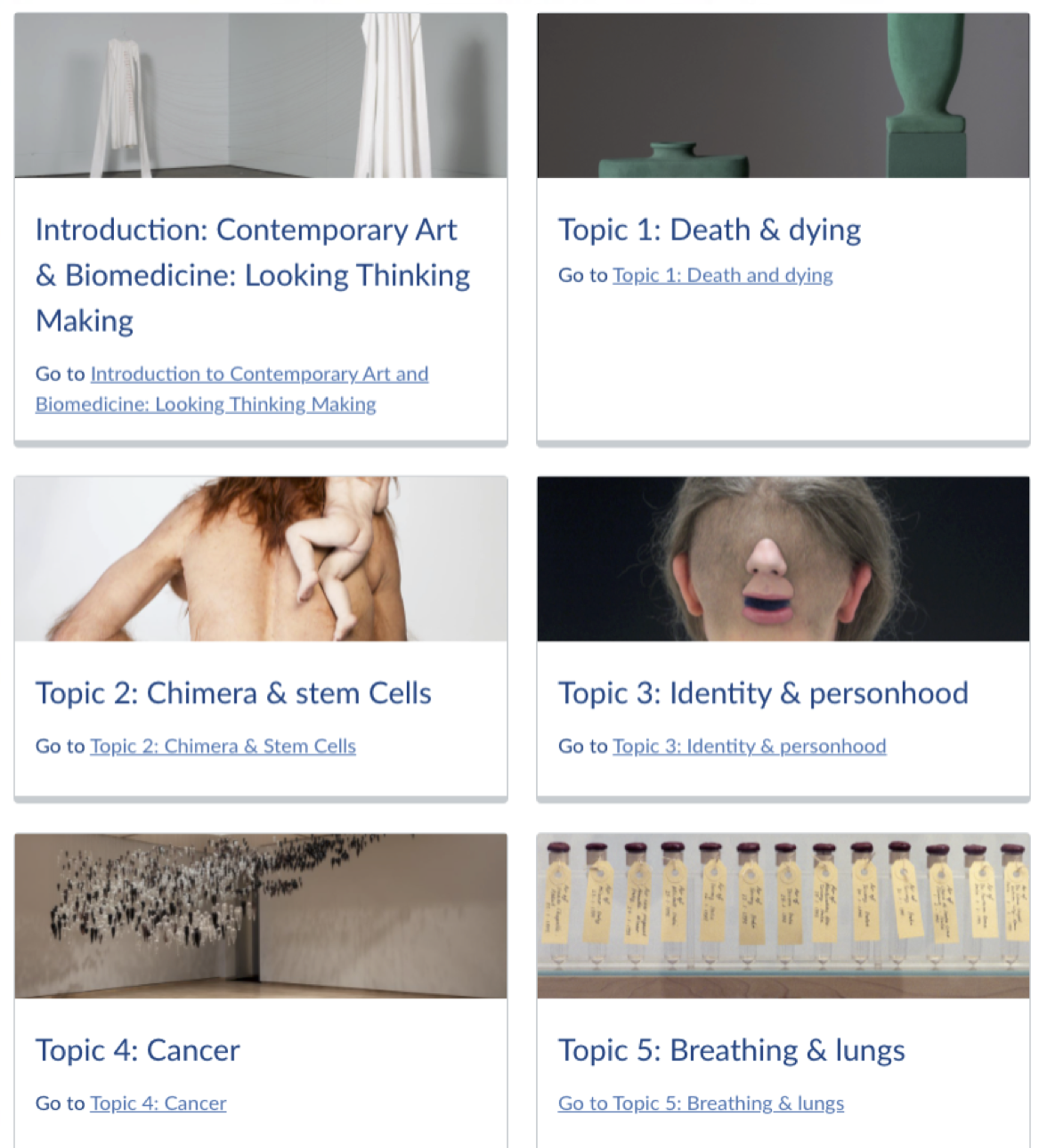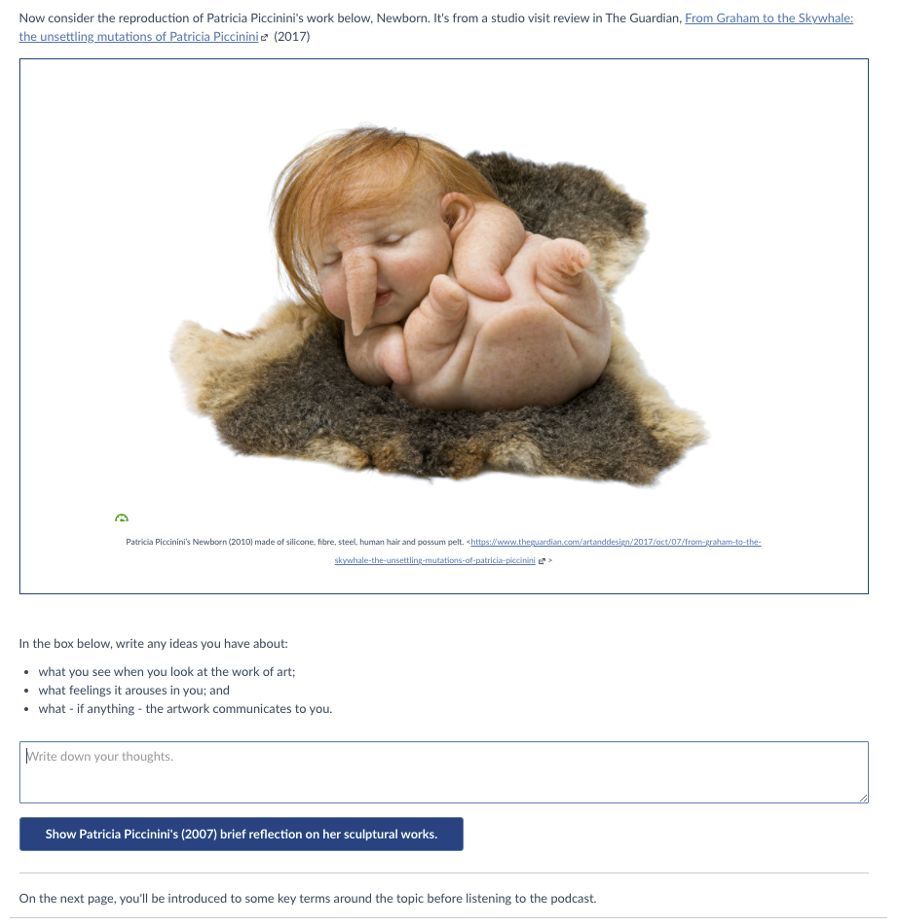When contemporary art meets biomedicine fully online and there are no right answers
Background
The pre-Covid earlier rounds of the University’s FlexAP program included a category for fully online, ‘signature’, and innovative new Melbourne subjects. Contemporary Art and Biomedicine: Looking Making Thinking (CREA10001) is an earlier FlexAP online subject that introduces students to approaches used by a selection of significant Melbourne artists to explore ways of seeing and thinking about biomedical practices and issues.
Contemporary Art and Biomedicine: Looking Making Thinking is a first-year breadth subject hosted by the Victorian College of the Arts (VCA) and targeted primarily at undergraduate biomedical students. The subject extends the medical education tradition of training budding physicians and researchers to look closely and deeply at images, events, phenomena to enhance skills of description, interpretation, evaluation and creation. In this way, it draws on traditional medical education practices like anatomical drawing classes to foster ways of observing meditatively. For example, the study of Fine Art has supported dermatology students at Yale Medical School to diagnose skin conditions (c. 1998), while Penn State College of Medicine incorporates art studies to enhance students’ bias awareness and empathy.
The approach
The approach the team has taken in developing this subject as a fully online is to create a curated suite of 6 ‘signature’ podcasts, hosted in the LMS and produced by Learning Environments learning designers and video production teams. The podcasts feature the six artists in ‘conversation’ with six Melbourne biomedical experts and the two subject coordinators exploring the modules’ key themes. At time of writing, Contemporary Art and Biomedicine: Looking Making Thinking is finishing its third iteration.

The six featured artists include alumni such as Professor Patricia Piccinini and Yhonnie Scarce; and the biomedical professionals include Professor Peter Doherty and Director of the Doherty Institute, Professor Sharon Lewin. The subject coordinators are Professor of Pharmacology, Gary Anderson, and VCA academic and Margaret Lawrence gallery curator, Doctor David Sequeira. The module topics range from ‘Stem cells and chimera’, to ‘Breathing and lungs’, to ‘Identity and personhood’. The ‘signature’ aspect of the subject is its showcasing of Melbourne University research and artistic expertise.
Contemporary Art and Biomedicine was designed and developed over a seven-month period The learning design approaches, taken from both a learning design perspective and a student learning perspective, were a mix of Community of Inquiry (Garrison 1996), Inquiry-based Learning, and Transformative Learning (Mezirow 2000). This was not the result of potluck or intuition, but from the subject coordinators (David, Gary) and the Learning Environments learning designer (Dr Julian Harris) research into Yale and Harvard Medical School examples and, crucially, anticipating the kind of concern from early biomedical students that gives this show case its title: It’s tricky when there’s no right answer at the end. The assessments (and their dependent Discussions) called for detailed description, interpretation, analysis, argument and, ultimately, creation of contemporary works of art.

Teaching and learning: asynchronous online learning sequences
Each of the six LMS modules followed an identical structure or asynchronous online learning sequence. There were only 4 x one-hour synchronous Zoom sessions across the semester. In keeping with the pedagogies above, modules began with a version of the question: What does Contemporary Art have to do with Topic X? The answer could, of course, be nothing, as David Sequeira reminded students at the outset of podcast recordings, or it could be everything depending on how students constructed arguments, or it might be somewhere in between.
Specifically, the accumulative learning sequences in each module supported students to explore more about the module’s artist and their work and the medical researcher and their expertise through diverse activities like collaboratively reading of a short article, viewing a recorded performance and responding to prompts, typing a short answer in a text area and comparing this with a triggered model response. On the third LMS page of each module, the podcast is embedded from Kaltura, following an interactive vocabulary exercise.
Podcasts and LMS Discussions: What happens to lectures and tutorial in the asynchronous fully online subject?
The podcasts did not ask or answer the question of what Topic X in the opinion of Artist Y or Expert Z had to do with that module’s guest artist and their work. The guests were interviewed separately by David and Gary; the raw recordings were listened to and discussed by David, Gary, Luis (Learning Environments – video production) and Julian. As the video production team edited a podcast episode down to c. 40-50 minutes, Gary, David, Julian devised complementary learning activities, including those mentioned, as well as LMS quizzes and Discussions.

Drawing on traditional ideas of learning and teaching, if we think of the podcasts as ersatz lectures, the ersatz tutorials are these learning sequences across several LMS pages with multiple opportunities for student self-reflection and self-assessment, and peer and tutor feedback. Fundamental to students’ active, independent, and collaborative learning, as well as to the development of a Community of Inquiry, are the asynchronous LMS Discussions. Each module’s Discussion activity introduced a collaborative and imaginative task, typically comprising two elements, for students with clear instructions and alignment to assessments and subject outcomes. Integral to the success of these discussions was the timely (twice per week) interventions of the tutor, Melbourne artist Trent Crawford.
The impact
For the learning designer, Julian Harris, the experience of collaborating with the Learning Environments video production team and the interdisciplinary academic team, to develop and deliver Contemporary Art and Biomedicine: Looking Making Thinking, demonstrates that fully online and asynchronous subjects can enhance and excite collaborative, creative and critical student learning without incorporating traditional, synchronous lectures or tutorials. In this way, students can access their learning materials flexibly and independently and can collaborate asynchronously and retrievably. With evidence-based and deliberate design, students encounter and engage with LMS learning materials across an accumulative, activity-rich, and coherent narrative and tutor resources are targeted to timely interventions (eg 2 x one-hour per week).
What’s next
To see what is involved with working with Learning Environments on your wholly online subject visit FlexAP wholly online subjects or to discuss your ideas for a wholly online subject contact Learning Environments.
References
- Blanding, M. (n.d). Art unleashes emotions and discussion among new doctors. Harvard Medicine. https://magazine.hms.harvard.edu/articles/museum-studies
- Learning as Transformation: Critical Perspectives on a Theory in Progress:, by Jack Mezirow and Associates. San Francisco, CA: Jossey–Bass, 2000. 371p. $38.95. ISBN 0-7879-4845-4. LC 00-009158. (2001). The Journal of Academic Librarianship, 27(5), 417. https://doi.org/10.1016/S0099-1333(01)00248-8
- Lesser, C. (2017, August 21). Why Med Schools Are Requiring Art Classes. Artsy. https://www.artsy.net/article/artsy-editorial-med-schools-requiring-art-classes
- The Community of Inquiry (website) https://coi.athabascau.ca/
- Yale School of Medicine (2021). Observational Skills - Use of Fine Art to Enhance Visual Diagnostic Skills. https://medicine.yale.edu/dermatology/education/obvskills/description/